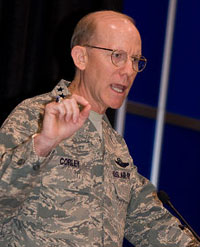Gen. Corley Invites Conversation on Joint Cooperation
Breaking with tradition and to a rousing round of applause, Gen. John D. Corley, USAF, commander, Air Combat Command and Air Component Commander, JFCOM, opened his presentation with the announcement that he would not be using PowerPoint slides to complement his speech. Instead, he invited the audience to have "a bit of conversation, a bit of a chat" about how the Air Force can help the services achieve dominance in the 21st century.
 Breaking with tradition and to a rousing round of applause, Gen. John D. Corley, USAF, commander, Air Combat Command and Air Component Commander, JFCOM, opened his presentation with the announcement that he would not be using PowerPoint slides to complement his speech. Instead, he invited the audience to have "a bit of conversation, a bit of a chat."
Referring to a military event that took place 64 years ago on this day, the general explained that a Japanese air attack not only was thwarted but was turned from a defensive fight to an offensive mission thanks to radar and courage. The radar enabled the U.S. Navy to preempt and beat back the attackers; the courage of the Navy leader of Task Force 58 led to an offensive that left the Japanese navy with three fewer carriers.
This look at history demonstrates the birth of the U.S. Air Force's relevance to the fight. Well-trained, well-equipped and well-led forces dominated the fight. This continues to be the case today; however, the difference is that the availability of technology, the pace of technology development and the number of enemy threats has increased exponentially.
But technology is only one element of remaining dominant, relevant and ready to accomplish missions today. "For the Air Force, we cannot simply man the machine; we must use the machine to accomplish our military missions," the general said.
What is being developed in this area is a national security strategy that focuses on the importance of joint cooperation. This strategy calls on each service to be responsible for more than one domain. "In my mind, support is not a bad word," Gen. Corley said.
For the Air Force, supporting this strategy will mean increasing the number of its aircraft-both manned and unmanned. "Perhaps, the Air Force has not invested enough in platforms," he said. "There will be an increased cost, but it must be a price we are willing to pay for dominance in the 21st century."
Listen to his complete address here (mp3 link):
Gen. John D. W. Corley, USAF, at the 2008 Joint Warfighting Conference
Breaking with tradition and to a rousing round of applause, Gen. John D. Corley, USAF, commander, Air Combat Command and Air Component Commander, JFCOM, opened his presentation with the announcement that he would not be using PowerPoint slides to complement his speech. Instead, he invited the audience to have "a bit of conversation, a bit of a chat."
Referring to a military event that took place 64 years ago on this day, the general explained that a Japanese air attack not only was thwarted but was turned from a defensive fight to an offensive mission thanks to radar and courage. The radar enabled the U.S. Navy to preempt and beat back the attackers; the courage of the Navy leader of Task Force 58 led to an offensive that left the Japanese navy with three fewer carriers.
This look at history demonstrates the birth of the U.S. Air Force's relevance to the fight. Well-trained, well-equipped and well-led forces dominated the fight. This continues to be the case today; however, the difference is that the availability of technology, the pace of technology development and the number of enemy threats has increased exponentially.
But technology is only one element of remaining dominant, relevant and ready to accomplish missions today. "For the Air Force, we cannot simply man the machine; we must use the machine to accomplish our military missions," the general said.
What is being developed in this area is a national security strategy that focuses on the importance of joint cooperation. This strategy calls on each service to be responsible for more than one domain. "In my mind, support is not a bad word," Gen. Corley said.
For the Air Force, supporting this strategy will mean increasing the number of its aircraft-both manned and unmanned. "Perhaps, the Air Force has not invested enough in platforms," he said. "There will be an increased cost, but it must be a price we are willing to pay for dominance in the 21st century."
Listen to his complete address here (mp3 link):
Gen. John D. W. Corley, USAF, at the 2008 Joint Warfighting Conference 



Comments